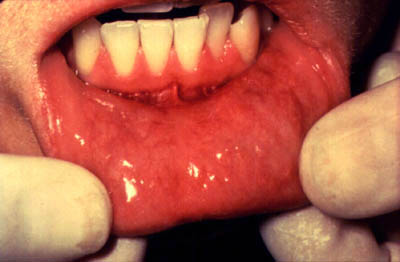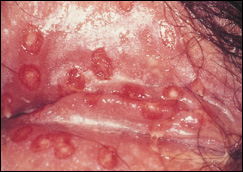Herpes simplex virus (HSV) causes myriad clinical presentations. The course depends on the age of the patient, the immune status of the host, the site of infection, the individual's previous immunity to autologous or heterologous viruses, and the antigenic type of the virus. Herpes simplex virus type 1 (HSV-1) typically causes infection above the waist and the infections are localized to mouth and oropharynx, whereas herpes simplex virus type 2 (HSV-2) usually causes genital infections and can also cause CNS or disseminated disease in neonates.
Compared with latent infection, primary infection with either virus is typically associated with systemic signs, increased severity of symptoms, and increased rates of complications. Upon reactivation, both viruses establish latent infections in sensory neurons and cause recurrent disease at or near the entry site into the body.
Orolabial infection

* Primary infection
o Most infections are caused by HSV-1 and are localized to the mouth and oropharynx. Only 10-30% of orolabial infections are symptomatic.
o The most common clinical presentation of first-episode, primary herpes simplex virus infection in children (usually aged 6 mo to 5 y) is acute herpetic gingivostomatitis.
o Clinical features include the following:
+ Abrupt onset of illness
+ Fever
+ Listlessness or irritability
+ Inability to eat and/or drink
+ Gingivitis (with markedly swollen, erythematous, and occasionally bleeding gums)
+ Increased drooling in infants due to pain on swallowing
+ Vesicular lesions on the tongue, buccal mucosa, and palate with extension, at times, to the lips and face (These may rupture and coalesce to form large, ulcerated areas.)
+ Tender submandibular or cervical adenopathy
o The lesions can be quite painful and symptoms may persist for 10-14 days. Primary herpes simplex virus infection of the oropharynx may be associated with viral shedding for as long as 23 days.
o Primary HSV-1 infection of the oropharynx in adolescents and adults usually manifests as pharyngotonsillitis rather than gingivostomatitis. Patients usually present with fever, malaise, odynophagia, and headache with vesiculoulcerative lesions on the tonsils.
o Primary HSV-2 infection can have a presentation similar to this after orogenital contact and it may occur concurrently with genital herpes simplex virus infection.
* Reactivation
o Reactivation of herpes simplex virus from the trigeminal ganglion is usually not associated with clinical findings. Reactivation of infection follows manipulation of the trigeminal nerve route or dental manipulation.
o Signs and symptoms associated with recurrences are usually mild. A prodrome of localized pain, tingling, burning, or itching is followed by eruption of vesicular lesions. The prodrome may occur 6-53 hours before the first vesicular lesions appear.
o The most common site of recurrent orolabial lesions is the outer edge of the vermilion border. On occasion, vesicles may be noted on other areas of the face or in the nares. The pattern of recurrent disease varies greatly from one person to the other. However, specific triggers may be fairly predictable for individual patients and the lesions tend to recur at the same site as the original lesions.
o HSV-1 orolabial infections recur at a rate of approximately 0.1 episode per month or 1.2 per year.
Genital infections

Primary infection occurs in the absence of preexisting antibodies to herpes simplex virus, either HSV-1 or HSV-2. First episode nonprimary infections occur in the absence of any previous signs or symptoms of genital herpes but in the presence of preexisting heterologous antibodies.
* Primary infection
o Primary, first-episode genital infections are characterized by severe constitutional symptoms, including fever, malaise, and mylagias. Itching and pain usually precede the development of symptoms by 1-2 days.
o Lesions evolve from vesicles to pustules to wet ulcers and heal by crusting. New lesions develop over 7-8 days. Lesions are distributed over labia majora, labia minora, mons pubis, vaginal mucosa, and cervix in women and over the shaft of the penis in men. Painful inguinal lymphadenopathy, dysuria, and vaginal discharge are frequent complaints. Complications in both sexes include paresthesias of the legs and perineum. Urinary retention, more common in women than in men, may be reported. Mean duration of viral shedding is 12 days.
o Preexisting antibodies to HSV-1 have an ameliorating effect on the severity of disease caused by HSV-2. Previous orofacial infection with HSV-1 generally protects a person against infection with HSV-1 but not HSV-2.
o Most primary genital herpes simplex virus infections are asymptomatic, and 70-80% of seropositive individuals have no history of symptomatic genital herpes. Periodic subclinical recurrences with viral shedding make them sources of infection.
o Nonprimary first episode infections have lower frequencies of systemic symptoms, fewer lesions and more rapid healing than in patients with primary infections, presumably due to preexisting heterologous antibodies.
* Reactivation
o Recurrences are more common with HSV-2 infections than with HSV-1 infections (5 vs 1 per y). Individuals with HSV-2 infection generally have high rates of recurrence in the first and second years followed by a substantial decrease in subsequent years (median, 2 per y). About 25% of individuals have at least one recurrence in 5 years.
o Most recurrences of genital herpes are asymptomatic. One percent of individuals with previous HSV-2 infection have viral shedding in the absence of clinical symptoms.
o Genital lesions are few and confined. Tender lymphadenopathy, dysuria, vaginal discharge, and systemic symptoms are less common. Factors implicated in recurrences include emotional stress and menses
Intrauterine and perinatal infections
* Congenital herpes simplex virus infection is a very rare entity and has been infrequently reported in the literature.31 Manifestations include skin lesions and scars, chorioretinitis, and microcephaly.
* Most neonatal herpes simplex virus infections result from exposure of the neonate to infected maternal genital secretions. The risk of the infection is largely influenced by the antibody status of the mother. About 50% of neonates exposed to maternal primary herpes simplex virus infection contract the virus as opposed to less than 5% of those exposed to recurrent herpes simplex virus disease.
* Neonates with herpes simplex virus infection manifest disease in 3 different ways as follows:
o Skin, eye, and mucous membrane (SEM) disease: Infection with herpes simplex virus limited to SEM historically accounts for about 20% of all neonatal herpes simplex virus infections. Infants with SEM infections generally present at age 10-12 days. Skin lesions tend to appear at the site of trauma. Many newborns with herpes simplex virus–related SEM disease do not present with symptoms of systemic illness. Outcome of SEM disease is excellent with prompt antiviral therapy; however, 75% of the cases progress to disseminated disease without treatment.
o Disseminated infection: Disseminated infection now accounts for approximately 25% of herpes simplex virus infections in newborns. The recognition and treatment of herpes simplex virus–related SEM disease early has resulted in lower rates of progression to disseminated disease than in years past. It usually presents during the first few days of life as severe bacterial infection. Clinical findings include jaundice, hepatomegaly, and respiratory dysfunction. Progression of infection is rapid in the absence of treatment.
o CNS infection: Nearly one third of infants with neonatal herpes simplex virus infection have encephalitis as the sole manifestation of disease. Patients usually present with symptoms and signs of illness at 2-3 weeks of age. Initial manifestations include lethargy, irritability, and focal seizures. Without treatment, most children with CNS disease die and survivors sustain severe neurologic impairment.
Herpes simplex virus CNS infection
* Herpes simplex virus encephalitis is the most common cause of severe sporadic CNS infection in the United States. One third of all cases of herpes simplex virus encephalitis are believed to occur in the pediatric population.
* Herpes simplex virus encephalitis may be a manifestation of primary or recurrent infection with the virus. The infection may have an insidious or an abrupt onset. Patients present with headache, altered consciousness, and focal neurological abnormalities with signs and symptoms consistent with temporal lobe involvement.
* Aseptic meningitis caused by herpes simplex virus can occur after primary genital HSV-2 infection. Patients with herpes simplex virus meningitis present with headache, fever, stiff neck, and photophobia. Symptoms usually begin 3-12 days after the onset of genital lesions. They reach maximum severity by 2-4 days into the illness, and gradually diminish over 2-3 days.
* Dysfunction of the autonomic nervous system and transverse myelitis has been associated with genital herpes simplex virus infection. Symptoms may include hyperesthesia or anesthesia of the lower back, perineum, or sacral region. Urinary retention and constipation are other associated symptoms.
Infection in immunocompromised hosts
* Severe herpes simplex virus infection in immunocompromised children is similar to that in adults. Infection is a frequent source of morbidity but is rarely fatal. The severity of disease is proportional to the deficiency of cellular immune responses.
* It is characterized by the presence of oral and genital lesions that progress slowly to involve contiguous mucosal surfaces and cause esophageal, tracheal or pulmonary involvement, leading to disseminated infection.
Other herpes simplex virus infections
* Patients with herpes simplex virus infection of the pulp or nail bed of the finger is referred to as herpetic whitlow.42 It presents with an acute onset of edema, erythema, and localized pain and tenderness in the finger. Associated fever and enlarged regional adenopathy are not uncommon.
* Herpes gladiatorum is a cutaneous infection seen among athletes participating in contact sports such as wrestling.43 It results in painful herpes simplex virus lesions, frequently with numerous cutaneous vesicles.
* Keratoconjunctivitis manifests with acute onset of pain, watery discharge, itching, blurred vision, lid swelling, and conjunctival injection Acute retinal necrosis can result in blindness.
* Mollaret meningitis, a recurrent aseptic meningitis is rarely associated with herpes simplex virus. Low-grade fever, headache, and myalgias may occur with these episodes. Approximately 50% of patients have transitory neurologic symptoms of meningeal irritation. The disease usually spontaneously remits over days.
* Herpes simplex virus is one of the most common precipitating factors for erythema multiforme (EM). Approximately 15% of patients with EM provide a history of recurrent herpes simplex virus infections before the characteristic skin lesions erupt.
